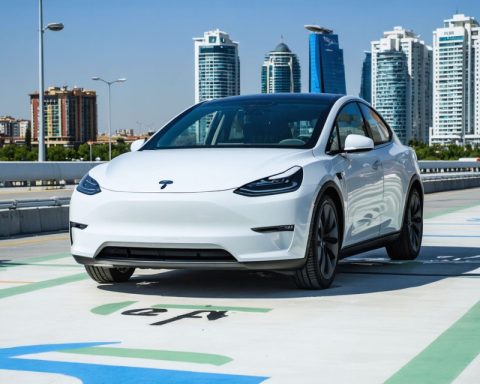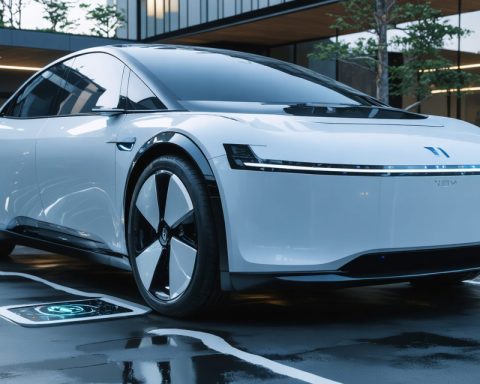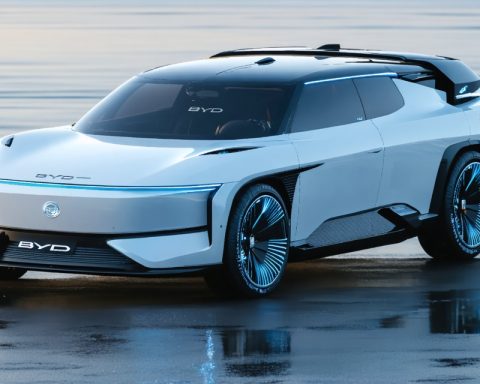- Researchers at the University of Chicago are pioneering PFAS-free battery solvents, targeting a greener future for electric vehicles (EVs).
- The team, led by Professor Chibueze Amanchukwu, developed two new solvent families that match or surpass traditional PFAS-based solutions in efficiency.
- These innovations include partially fluorinated non-PFAS solvents for lithium-ion batteries and completely non-fluorinated versions for lithium-metal variants.
- The new batteries demonstrate improved ion pairing, capacity retention, and temperature adaptability, maintaining stability from -40 to 60 degrees Celsius.
- By eliminating “forever chemicals,” researchers aim for longer-lasting, faster-charging batteries with minimal environmental impact.
- The initiative strives to reduce PFAS reliance, promoting sustainable advancements in battery and technology sectors.
- This research underscores the potential for harmony between technological progress and environmental health.
Nestled within the bustling halls of the University of Chicago’s Pritzker School of Molecular Engineering, a group of visionary researchers has taken a leap toward a greener future by redefining the foundation of electric vehicle (EV) batteries. Their groundbreaking work sheds light on a future where the persistent, environmentally harmful “forever chemicals”—per- and polyfluoroalkyl substances (PFAS)—could become relics of the past.
In a world thirstily racing towards sustainable energy, the demand for efficient and environmentally benign batteries has never been higher. Yet the shadow of PFAS—ubiquitously used for their chemical stability—looms large. Despite their utility, these substances are notorious for infiltrating ecosystems and persisting long after their initial use.
Embracing the challenge, researchers led by Professor of Molecular Engineering Chibueze Amanchukwu and industrious PhD candidate Peiyuan Ma have pioneered two new families of PFAS-free solvents. These innovations promise not only to match the performance of their PFAS-laden counterparts but to also transcend them in effectiveness.
Flashes of inspiration led the team to concoct partially fluorinated non-PFAS solvents fitted for lithium-ion batteries and completely non-fluorinated ones for lithium-metal variants. The goal was not just ecological responsibility but technical superiority—achieving a powerful symbiosis. Their experiments revealed that the non-fluorinated lithium metal battery designs boasted unmatched ion pairing and capacity retention. Equally impressive, lithium-ion prototypes showcased remarkable endurance and adaptability, maintaining stable operations across a wide swath of temperatures, from a blistering 60 down to a chilling -40 degrees Celsius.
Peering deeper into the atomic ballet of battery components and solvent interactions, the researchers unearthed the secrets of crafting robust, resilient batteries without resorting to “forever chemicals.” Their findings suggest that next-generation batteries can offer enhanced longevity and faster charging rates without escalating environmental debts—a vision eagerly embraced by the sustainability-focused scientific community.
This profound shift aligns seamlessly with the researchers’ overarching goal: to guide the industry away from harmful PFAS reliance, ushering in an era where “never chemicals” form the bedrock of technology. By building a bridge to safer, economically viable alternatives, the UChicago PME team not only lays new groundwork for battery technology but sparks the imagination for what’s possible in a cleaner, greener world.
The message is clear—there doesn’t need to be a trade-off between high-tech progress and planetary health. With each barrier they surmount, the researchers bring us one step closer to a time when our strides towards technological advancement are in harmony with the natural world. As the research unfolds, it continues to offer us a tantalizing glimpse of the sustainable future we could build together.
Revolutionizing Electric Vehicle Batteries: The PFAS-Free Leap Toward a Sustainable Future
Redefining Electric Vehicle Battery Technology
The cutting-edge research at the University of Chicago’s Pritzker School of Molecular Engineering introduces a paradigm shift in electric vehicle (EV) battery technology by eliminating PFAS (per- and polyfluoroalkyl substances). These “forever chemicals” have long been a staple due to their chemical stability, but their ecological impact has spurred demand for cleaner alternatives.
The Importance of Moving Away from PFAS
PFAS are persistent in the environment, leading to widespread contamination and health concerns. Transitioning to PFAS-free solutions can significantly reduce the ecological footprint of battery production and use. This aligns with global efforts to advance sustainability.
Innovative Solvent Families
The research team engineered two PFAS-free solvent categories: partially fluorinated solvents for lithium-ion batteries and non-fluorinated ones for lithium-metal batteries. These not only reduce environmental harm but also offer superior technical benefits.
Key Features and Benefits
1. Enhanced Battery Performance:
– Non-fluorinated lithium-metal batteries show superior ion pairing and capacity retention.
– PFAS-free lithium-ion batteries maintain stable performance across temperature extremes (-40°C to 60°C).
2. Sustainability and Ecology:
– By removing PFAS, batteries become less intrusive on ecosystems.
– Adoption of these technologies could significantly reduce pollution linked to traditional battery manufacturing.
3. Technological Superiority:
– Improved charge times and battery lifespan.
– Potential for cost-effective mass adoption in the EV market.
Industry Implications and Market Forecast
The move away from PFAS could define the next wave of battery innovation, estimated to grow at a CAGR of over 15% in the next decade (Source: MarketsandMarkets). Companies investing early in PFAS-free technologies may gain a competitive edge.
Potential Challenges
1. Scalability:
– Transitioning current manufacturing processes to accommodate new solvents could require significant investment.
2. Regulatory Acceptance:
– New chemical formulations might face prolonged approval processes.
3. Market Education:
– Educating manufacturers and consumers about benefits and changes is crucial for widespread adoption.
How to Implement PFAS-Free Battery Solutions
For manufacturers looking to transition:
1. Assess Current Processes: Understand existing production reliance on PFAS compounds.
2. Collaborate with Innovators: Partner with research institutions like the University of Chicago for technology transfer.
3. Regulatory Alignment: Work with regulatory bodies to ensure compliance with new formulations.
4. Educate Stakeholders: Promote understanding of the ecological and performance benefits of PFAS-free batteries.
Conclusion: Taking Action Today
The shift to PFAS-free battery technology is not just about ecological responsibility—it’s about driving superior performance and preparing for future industry needs. As companies and consumers alike become more eco-conscious, only those proactive in adopting these innovations will lead the way.
For further reading on sustainable innovations, visit the University of Chicago.
Quick Tips for Consumers
– Inquire about Battery Composition: When purchasing an EV, ask if it uses sustainable battery technology.
– Support Eco-friendly Brands: Choose brands actively reducing their environmental impact.
By aligning our technological strides with ecological responsibility, we pave the way for a flourishing, sustainable future.













